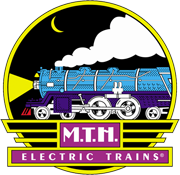January 2015 RailKing Product Spotlight - Center I-Beam Flat Car

RailKing O Gauge Center I-Beam Flat Car
Introduced in the late 1960s, the centerbeam flat car was a logical evolution of the bulkhead flat, which had been developed to prevent loads like pipe and poles from shifting in transit. Adding the center beam made the car body more rigid and stable, and added additional load bracing and cargo tie-down points. The Northern Pacific Railway rostered the first centerbeams, built by Thrall Car Manufacturing Co. According to TTX, owner of North America’s largest fleet of centerbeam flats, their original purpose was to carry pipe, steel beams, and girders.
But in the mid-1970s the centerbeam flatcar found its true calling: as the vehicle of choice for the lumber industry, delivering dimensional lumber (1x3s, 2x4s, etc) and sheets of plywood, particle board, and other building products. Advances in packaging had made it possible to ship wood products in plastic-wrapped packages protected from the elements, enabling the open centerbeam flat, which was easier to load and unload, to replace the all-door boxcar as the continent’s lumber carrier. (Interestingly, Thrall was building the initial fleets of all-door boxcars at almost the exact same time it introduced the car that would later replace them.)
A defining feature of centerbeams is that they must be loaded from both sides, making them inappropriate for use at a typical loading dock. Because cargo is placed on either side of the car’s center, a centerbeam will tip over if not loaded and unloaded evenly from both sides. A forklift is typically used for loading wrapped stacks of building products, and the deck of a centerbeam has raised ridges to support the bottom stacks while allowing the tines of a fork lift to slip under the load.
Our RailKing model is based on the Thrall 63’ “opera window” centerbeams built for the lumber industry in the mid-1970s and later — so-named for the weight-saving oval cutouts in their steel centerbeams. Many are still plying the rails today, alongside longer 73’ cars with girder-type centerbeams that were produced by several car builders from the mid-1980s to the present day. Because these cars are rostered by numerous railroads and go wherever the loads are, it’s prototypical to have various railroads represented in a string of centerbeams picking up at a mill or building products producer.
WHERE TO BUY
Each of the above RailKing items can be ordered through any M.T.H. Authorized Retailer.
Product Features
Product Features:
- Intricately Detailed Durable ABS Body
- Metal Wheels and Axles
- Die-Cast 4-Wheel Trucks
- Operating Die-Cast Metal Couplers
- Colorful, Attractive Paint Schemes
- Decorative Brake Wheels
- Fast-Angle Wheel Sets
- Needle-Point Axles
- Removable Lumber Load
- Unit Measures:15” x 2 3/8” x 3 15/16”
- Operates On O-31 Curves










